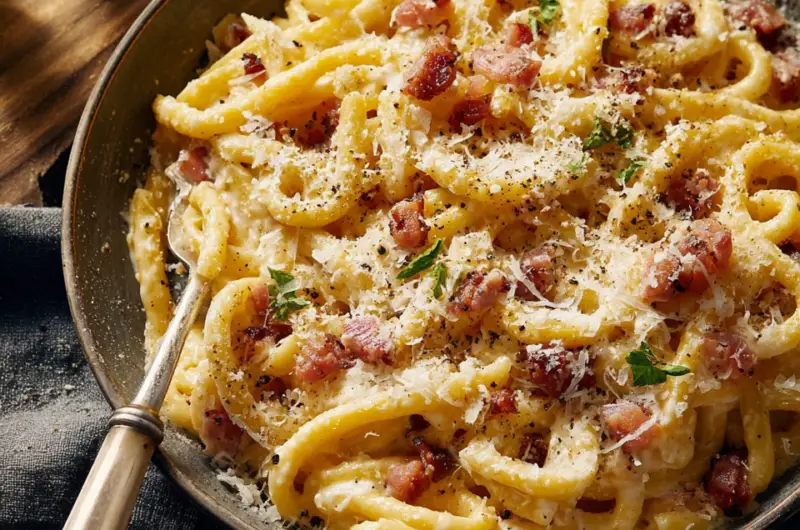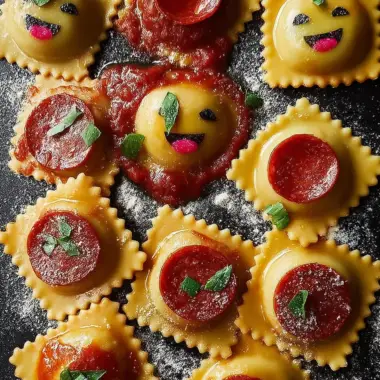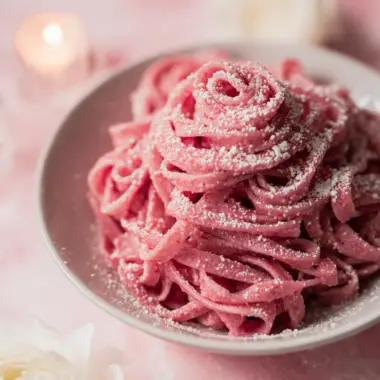Bucatini alla Carbonara is one of Italy’s most cherished pasta dishes simple in ingredients yet packed with bold, comforting flavor. Originating in Rome, this dish beautifully balances crispy guanciale, velvety egg yolks, sharp Pecorino Romano, and the toothsome bite of bucatini pasta. Each twirl delivers a creamy, peppery, and savory experience that’s both elegant and heartwarming. Unlike many modern variations that include cream or garlic, traditional carbonara relies solely on the magic of its core components. The hot pasta and rendered guanciale fat emulsify the egg yolks and cheese into a luscious sauce, coating every strand. It’s a prime example of how classic Italian cooking brings maximum flavor with minimal fuss. This dish is perfect for date nights, weeknight indulgence, or impressing friends with a taste of Rome in your own kitchen.
Full Recipe:
Ingredients:
-
400g bucatini pasta
-
150g guanciale, diced
-
4 large egg yolks
-
50g Pecorino Romano cheese, finely grated
-
Freshly ground black pepper
-
Salt, to taste
Directions:
-
Bring a large pot of salted water to a boil and cook bucatini until al dente, according to package instructions.
-
Meanwhile, heat a large skillet over medium heat and cook the diced guanciale until crispy and golden, about 5–7 minutes. Set aside but reserve the rendered fat.
-
In a mixing bowl, whisk the egg yolks with grated Pecorino Romano and a generous amount of black pepper until smooth and creamy.
-
Drain the pasta, reserving about 1/2 cup of the pasta water.
-
Quickly toss the hot bucatini with the crispy guanciale and rendered fat. Remove from heat.
-
Stir in the egg yolk mixture, using the reserved pasta water a little at a time to create a silky sauce that coats the pasta without scrambling the eggs.
-
Serve immediately with an extra sprinkle of Pecorino Romano and freshly cracked black pepper.
Prep Time: 10 minutes | Cooking Time: 15 minutes | Total Time: 25 minutes
Kcal: 510 kcal | Servings: 4 servings
The Art of Bucatini alla Carbonara: A Roman Culinary Masterpiece
When it comes to classic Italian cuisine, few dishes rival the elegance and comforting richness of Bucatini alla Carbonara. This traditional Roman pasta dish has made its way into kitchens and restaurants across the world, admired for its creamy texture, savory depth, and minimalist ingredients. Despite its simplicity, making an authentic carbonara requires technique, timing, and respect for tradition. It is a celebration of culinary restraint bringing together guanciale, egg yolks, Pecorino Romano, and bucatini pasta in perfect harmony.
In this article, we explore the story behind Bucatini alla Carbonara, what makes it such a beloved Italian staple, and why its traditional form remains one of the most celebrated dishes in Roman cooking.
Origins and Cultural Significance of Carbonara
Carbonara is believed to have emerged in the Lazio region of Italy, with strong ties to Rome. While the exact history is debated, many historians suggest the dish originated during or shortly after World War II. One theory points to American soldiers in Italy combining their rations namely eggs and bacon with local pasta, creating an early version of the dish. Italian cooks, using their own cured pork and cheese, refined it into what we now know as Carbonara.
The name “carbonara” itself is often attributed to “carbonari” (charcoal workers), possibly indicating that the dish was a favorite among laborers or that it resembles specks of coal (from the black pepper). Others believe it refers to the smoky, charred flavor of guanciale and the rustic feel of the dish.
What is certain, however, is that Carbonara holds a cherished spot in Italian culinary identity. It stands as a testament to the philosophy of “la cucina povera” a cooking tradition that uses humble ingredients to produce remarkable flavors.
Bucatini: The Perfect Pasta for the Job
While spaghetti is often used for Carbonara, bucatini is a more traditional and satisfying choice. This thick, spaghetti-like pasta with a hollow center is especially popular in Rome and central Italy. The tube-like structure allows sauce to coat both the outside and interior, delivering bursts of flavor with every bite.
Bucatini’s ability to absorb and hold onto the creamy egg-and-cheese sauce makes it ideal for Carbonara. It creates a texture that is both hearty and indulgent without being overly heavy. When twirled with crisp guanciale and a rich yolk-based sauce, it offers a mouthfeel that is truly divine.
The Essential Elements of Authentic Carbonara
What distinguishes an authentic Carbonara from its modern, often cream-laden cousins is its strict reliance on traditional ingredients and methods. True Roman Carbonara includes just a handful of elements: egg yolks, guanciale, Pecorino Romano, black pepper, and pasta. Each plays a crucial role in the dish’s character:
Guanciale
This cured pork cheek is a Roman specialty. Unlike pancetta or bacon, guanciale has a higher fat content and delivers a rich, melt-in-your-mouth texture when cooked. Its rendered fat forms the base of the sauce, offering an unmatched depth of flavor.
Egg Yolks
Egg yolks are responsible for the creamy texture of Carbonara. When properly emulsified with the pasta water and cheese, they create a luxurious coating that rivals any cream-based sauce—without the cream.
Pecorino Romano
Sharp and salty, Pecorino Romano is the cheese of choice in Roman pasta dishes. It adds complexity and balances the richness of the yolks and guanciale with its pungent, tangy flavor.
Black Pepper
Freshly ground black pepper is not just a seasoning in Carbonara it’s a signature flavor. It adds heat and earthiness, elevating the other ingredients and providing contrast to the richness of the sauce.
Pasta Water
Often overlooked, starchy pasta water is critical to achieving a silky, cohesive sauce. It helps the cheese and yolks emulsify without curdling, binding the sauce to the pasta seamlessly.
Technique: Where Simplicity Meets Skill
Despite its short ingredient list, Carbonara is famously easy to mess up. The key lies in timing and temperature control. The pasta must be hot enough to cook the eggs into a sauce but not so hot that it scrambles them. Similarly, the cheese must be incorporated smoothly, avoiding any clumping.
One of the most debated aspects of the dish is the method of combining the elements. Some chefs prefer to mix the egg and cheese mixture off the heat, while others rely on residual warmth from the pasta and pan. Regardless of approach, the goal is the same: a glossy, creamy sauce that clings to every strand of pasta without separating.
Another technical element is the rendering of guanciale. It should be crispy, golden, and not burnt offering a contrast in texture and a concentrated pork flavor that infuses the entire dish.
Modern Twists and Common Variations
In kitchens outside Italy, Carbonara has undergone numerous adaptations. Some add cream for ease of preparation or to mask overcooked eggs. Others substitute pancetta or even bacon for guanciale due to availability. While these versions may taste good in their own right, they stray from the purity of the original dish.
There are also plant-based and vegetarian takes, using mushrooms or smoked tofu in place of guanciale, and plant-based cheeses for Pecorino Romano. These versions aim to replicate the umami and texture of the traditional dish while accommodating different diets.
However, purists agree: nothing beats the real deal, especially when made with care and the right ingredients.
When and How to Serve Bucatini alla Carbonara
Bucatini Carbonara is incredibly versatile. It can be a comforting solo dinner, a romantic meal for two, or the highlight of an Italian-themed dinner party. Because of its richness, it pairs well with light appetizers such as a crisp green salad, roasted vegetables, or a chilled glass of dry white wine like Frascati or Pinot Grigio.
The dish should be served immediately after preparation. It loses its creamy texture if left sitting or reheated, making it a dish best enjoyed fresh and hot from the pan.
Why Bucatini alla Carbonara Deserves a Spot on Your Table
Beyond its irresistible taste, Bucatini alla Carbonara embodies the heart of Italian cooking: simplicity, quality ingredients, and attention to detail. It’s a recipe that’s passed down through generations, connecting diners to a long lineage of Roman culinary tradition.
In today’s world, where food trends come and go, Carbonara remains timeless. It doesn’t require fancy tools, rare ingredients, or hours in the kitchen. Instead, it rewards precision and care a reminder that cooking can be both humble and transcendent.
Conclusion:
If you’ve never tried making authentic Bucatini alla Carbonara at home, now is the time. It’s a dish that showcases how a few well-chosen ingredients, treated with respect, can create something unforgettable. Whether you’re a pasta enthusiast, an aspiring home chef, or someone who simply loves a good comfort meal, Carbonara offers warmth, flavor, and satisfaction in every forkful.








